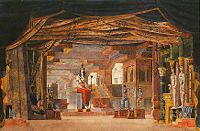- Mosè in Egitto
-
Mosè in Egitto (pronounced [moˈzɛ in eˈdʒitto]; English: Moses in Egypt) is a three-act opera written by Gioachino Rossini to a libretto by Andrea Leone Tottola, which was based on a play by Francesco Ringhieri, L'Osiride, of 1760.[1]
It premiered 5 March 1818 at the recently reconstructed Teatro San Carlo, Naples.
Rossini enlarged the work in 1827, this time to a French libretto. Moïse et Pharaon, ou Le passage de la Mer Rouge (pronounced: [mɔiːz e faʁaɔ̃ u lə pasaːʒ də la mɛːʁ ʁuːʒ]; English: Moses and Pharaoh, or The Crossing of the Red Sea) is in four acts, with a ballet. It received its premiere in Paris on 26 March.
Contents
Composition history
The opera was loosely based on the Exodus from Egypt of the Israelites, led by Moses, rendered agreeable to the opera stage by introducing a love theme, in which the Pharaoh's son Amenophis (tenor) plans to prevent their departure, since he loves the Israelite Anaïs (soprano). The opera opens with a darkened stage, as the plague of darkness is dispelled by Moses' prayer, and it ends with the spectacle of the parting of the Red Sea and the drowning of Pharaoh's host, which "elicited howls of derision"[2] at the clumsy machinery of its staging at the premiere, though the opera surmounted its technical failings and was a hit.
Billed as an azione tragico-sacra, the sacred drama with some features of the oratorio circumvented proscriptions of secular dramatic performances during Lent.
Rossini revised the opera for Naples in 1819, when he introduced Moses' prayer-aria '"Dal tuo stellato soglio", which became one of the most popular opera pieces of the day, inspired a set of variations for violin and piano by Niccolò Paganini, and survives in concert performance.
Performance history
Parisian audiences had already seen the work, both in a performance by the Paris Opéra at the Théâtre de l'Académie Royale de Musique and at the Théâtre des Italiens before Rossini revised it for the Paris Opéra, now in four acts with a ballet, where it premiered 26 March 1827, with the title Moïse et Pharaon, ou Le Passage de la Mer Rouge, with translations and additions to the libretto by Luigi Balocchi [3] and Victor Joseph Etienne de Jouy, who would co-write the libretto for Rossini's final opera Guillaume Tell.
Roles
Role
Naples version/Paris versionVoice type Naples premiere cast,
March 5, 1818
(Conductor: Nicola Festa)Paris revised version premiere,
March 26, 1827
(Conductor: - )Mosè / Moïse (Moses) bass Michele Benedetti Nicholas-Prosper Levasseur Faraone / Pharaon (Pharaoh) bass Raniero Remorini Henri-Bernard Dabadie Amaltea / Sinaide, his wife soprano Frederike Funck Louise-Zulme Dabadie Osiride / Aménophis, their son tenor Andrea Nozzari Adolphe Nourrit Elcia / Anaï, a Hebrew girl soprano Isabella Colbran Laure Cinti-Damoreau Aronne / Elézer (Aaron) tenor Giuseppe Ciccimarra Alexis Dupont Amenofi / Marie (Miriam), Moses' sister mezzo-soprano Maria Manzi Mori Mambre / Aufide, a priest tenor Gaetano Chizzola Ferdinand Prévôt (no role) / Osiride, the High Priest bass Bonel (no role) / A mysterious voice bass Bonel Instrumentation
The score calls for: 2 Flutes/2 Piccolos, 2 Oboes, 2 Clarinets, 2 Bassoons, 4 Horns, 2 trumpets, 3 Trombones, Serpent, Timpani, Bass Drum, cymbals, Triangle, Banda Turca, Harp, Strings.
Onstage: Band (Piccolo, Quartino, 4 Clarinets, 2 Horns, 4 Trumpets, 2 Trombones, Serpent, Bass Drum)
Synopsis
- Place: Egypt
- Time: Around 1230 B.C.[4]
Act 1
Act 2
Act 3
On the shores of the Red Sea
Recordings
Year Cast:
Mosè, Aronne, Elcia, FaraoneConductor,
Opera House and OrchestraLabel [5] 1956 Nicola Rossi-Lemeni,
Mario Filippeschi,
Caterina Mancini,
Giuseppe TaddeiTullio Serafin,
???? 1987 Ruggero Raimondi,
Salvatore Fisichella,
June Anderson,
Siegmund NimsgernClaudio Scimone,
Philharmonia Orchestra and the Ambrosian Opera ChorusAudio CD: Philips,
Cat: 420 109-21993 Roberto Scandiuzzi,
Ezio Di Cesare,
Mariella Devia,
Michele PertusiSalvatore Accardo,
Teatro San Carlo di Napoli Orchestra and Chorus
(Audio and video recordings of a performance (or of performances) in the Teatro San Carlo di Napoli)DVD: House of Opera
Cat: DVDBB 2113References
- Notes
- ^ Ringhieri
- ^ Holden, p. 783
- ^ Balocchi, the conductor and director of the Théâtre des Italiens, had provided the libretto for Rossini's first Paris production, the coronation opera Il viaggio a Reims, 1825, and for Le siège de Corinthe, a French version of Maometto II.
- ^ Osborne, C. p. 81
- ^ Recordings of ‘’Mosè in Egitto’’ on operadis-opera-discography.org.uk
- Cited sources
- Holden, Amanda (Ed.), The New Penguin Opera Guide, New York: Penguin Putnam, 2001. ISBN 0-140-29312-4
- Osborne, Charles, The Bel Canto Operas of Rossini, Donizetti, and Bellini, Portland, Oregon: Amadeus Press, 1994 ISBN 0931340713
- Ringhieri, Francisco, L'Osiride. Tragedia del p.d. Francesco Ringhieri monaco ulivetano e lettore di teologia. Padua: Conzatti, 1760. Eight volumes of the tragedies of Ringhieri, an Olivetan monk 1721-1787), were also published in Venice 1788-89.
- Other sources
- Osborne, Richard, Rossini, Ithaca, New York: Northeastern University Press, 1990 ISBN 1555530885 ISBN 1-55553-088-5
External links
Categories:- Operas by Gioachino Rossini
- Italian-language operas
- 1818 operas
- Operas
- Operas set in Egypt
- Moses
- Teatro San Carlo world premieres
- Operas based on the Bible
Wikimedia Foundation. 2010.



